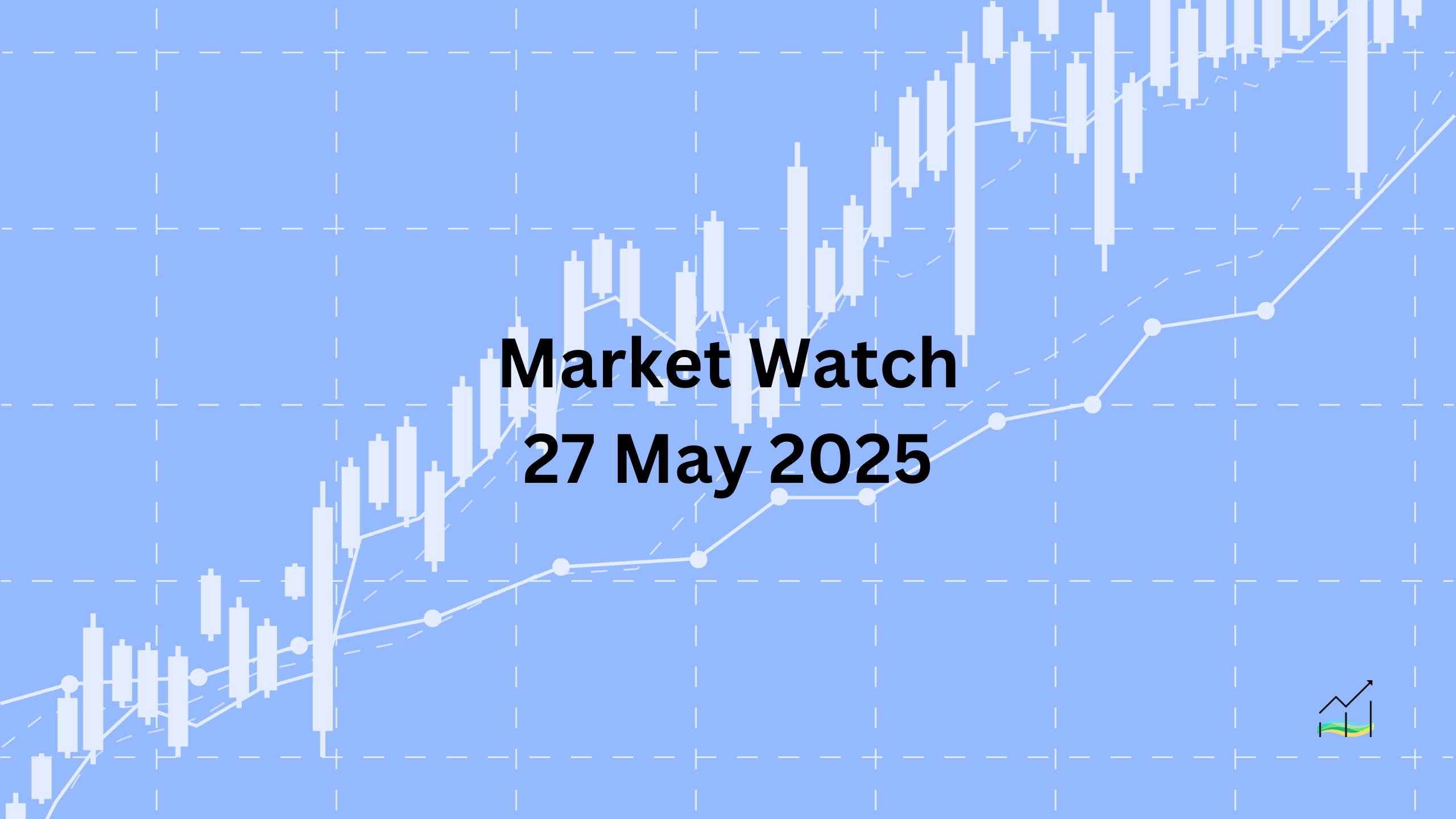27/05/2025 Market Watch

Dollar Rebounds on Yen Weakness, Gains May Be Short-Lived
Key Takeaways:
- The yen weakens sharply amid speculation of Japanese bond market intervention.
- Dollar regains ground across G10 currencies, but momentum suggests limited upside.
- US and European bond yields fall modestly.
- Equity markets mostly rebound, though Asia shows mixed performance.
- Gold retreats while oil extends recent gains.
The US dollar began the week on firmer footing, bouncing back after a poor finish last week, largely due to speculation that Japan may step in to stabilise its bond market. A significant drop in Japanese long-term bond yields has triggered renewed volatility, with the yen taking the hardest hit among G10 currencies. It has fallen nearly 0.75% today, fuelling a round of short covering in the dollar. However, the rally may prove temporary as sentiment suggests that North American participants could look to fade this strength.
In global bond markets, yields are modestly lower. European benchmark 10-year yields have slipped by 1 to 3 basis points, while the US 10-year Treasury yield is down four basis points, hovering around 4.47%. This softening in yields is being closely watched as markets weigh central bank trajectories and geopolitical risks.
Equity markets are showing signs of recovery. Despite some underperformance in Asia, particularly in China and Taiwan, European stocks are regaining lost ground. The Stoxx 600, which declined over three days last week, is now nearly flat after two days of gains. In the US, index futures point to a strong start, rising between 1.3% and 1.7%.
Commodities are mixed. Gold is trading lower, falling back to levels seen before the weekend, near $2,290. Meanwhile, oil prices continue their upward trend. July WTI futures, which held the $60 level late last week, have risen toward $62, consolidating Monday’s advance.
United States of America
Overview
Markets are reacting to a temporary delay in the enforcement of proposed US tariffs on European Union goods, with the 50% tariff now postponed until 9 July. This delay, coming ahead of the expiration of a 90-day grace period, is widely interpreted as a negotiation tactic rather than a final decision. The euro had already recovered much of its earlier losses before the weekend, reflecting market skepticism about the tariffs being implemented. Despite the uncertainty, the postponement contributed to further weakness in the Dollar Index, which touched a new monthly low of 98.70 before rebounding to 99.40 on short covering triggered by Japan-related developments.
Today also marks the reopening of US financial markets after a long weekend. Investor focus is turning toward fresh economic data, especially April's durable goods orders. A sharp drop in Boeing orders is expected to weigh on the headline figure, though underlying data may signal some stability. House price data for March and the Conference Board’s consumer confidence reading for May are also on deck, with sentiment expected to show mild improvement following a five-year low in April.
Economic Drivers
- Delay in 50% tariffs on EU goods now pushed to 9 July, widely seen as a negotiation strategy.
- Tariff developments contributed to Dollar Index volatility and euro strength.
- Short covering triggered by stabilisation efforts in Japan’s bond market added upward pressure on the dollar.
- US market participants return after a long holiday, increasing liquidity and volume.
- Anticipation of economic data releases influencing near-term sentiment.
Data and Events
- 27 May 2025: Durable Goods Orders.
- 27 May 2025: CB Consumer Confidence.
Price Action
- Dollar Index dropped to 98.70 before rebounding to 99.40; resistance seen near 99.50.
- A break above 99.50 could open the path to 100.00.
- Tariff-related sentiment and Japanese bond news drove volatility in FX markets.
Key Points:
- US delays EU tariff decision to 9 July, easing short-term pressure on the euro.
- Dollar Index volatility driven by both policy speculation and foreign bond market moves.
- US economic data expected to show mixed results, with soft durable goods and modest consumer confidence recovery.
- Market liquidity returns as US reopens after holiday.
Australia & New Zealand
Overview
The Australian dollar briefly reached a new high for the year above $0.6535 before easing back toward $0.6445 in European trading. The move had been building toward the $0.6550 level, marking a key Fibonacci retracement of the decline from September’s peak near $0.6940. However, near-term softness emerged ahead of tomorrow’s inflation data.
Australia’s April monthly CPI will be closely watched, but even a softer reading is unlikely to influence the Reserve Bank of Australia’s policy stance ahead of its next meeting on 8 July. Inflation has remained steady between 2.4% and 2.5% in recent months, and forecasts suggest a dip to 2.2%, the lowest since October 2023.
In contrast, the Reserve Bank of New Zealand is poised to act. The RBNZ is widely expected to cut interest rates by 25 basis points to 3.25% at its policy meeting tomorrow. Market pricing also indicates expectations for another cut by year-end, with a slightly better than even chance of an additional reduction.
Economic Drivers
- The Australian dollar pulled back after reaching its highest level this year.
- Australia’s inflation has been stable but is expected to ease in April.
- The RBA is unlikely to base its July decision on this CPI release.
- The RBNZ is expected to cut its policy rate by 25 basis points.
- Markets are already pricing in at least one more RBNZ rate cut by the end of the year.
Data and Events
No major economic releases are scheduled today.
Price Action
- AUD/USD hit a yearly high above $0.6535 before falling to around $0.6445.
- $0.6550 represents a key retracement level from last September's high of $0.6940.
Key Points:
- AUD hit a new high for the year but weakened ahead of key data.
- Australia’s inflation likely softened in April, but the RBA’s July policy is not expected to hinge on it.
- RBNZ is expected to cut rates and could ease further this year.
- Markets are positioning around central bank divergence in the region.
Canada
Overview
The Canadian dollar has strengthened steadily since February, when the US dollar peaked near CAD1.48—its highest level since 2003. Yesterday, the greenback slipped to a fresh low near CAD1.3685 before showing signs of recovery. This latest move suggests the possibility of a near-term base forming for USD/CAD, as it nears key technical levels. Market attention now turns to upcoming economic data, particularly Canada’s Q1 GDP due on 30 May.
The swaps market has significantly reduced its expectations for a Bank of Canada rate cut, with the implied probability falling to around 30% following the latest CPI release, down from more than 65% previously. Over the weekend, BoC Governor Tiff Macklem stated in interviews that US tariff threats remain the biggest external risk to the Canadian economy, highlighting continued trade-related concerns.
Economic Drivers
- The Canadian dollar has appreciated since February, supported by reduced BoC rate cut expectations.
- Swaps market pricing for a rate cut dropped sharply after the recent inflation report.
- Bank of Canada Governor Macklem flagged US tariffs as the most significant external threat to Canada’s economic outlook.
- Expectations are building around Q1 GDP, with concerns of contraction in the current quarter.
Data and Events
No major economic releases are scheduled today.
Price Action
- USD/CAD reached a marginal new low near CAD1.3685 before rebounding.
- Price action suggests potential near-term bottom, with resistance around CAD1.3780–CAD1.3800.
- The pair is testing a key uptrend line near CAD1.3680.
Key Points:
- Canadian dollar strengthened to fresh multi-month highs as USD slipped.
- BoC rate cut odds fall sharply post-CPI, now near 30%.
- Governor Macklem highlights US tariffs as Canada’s main economic risk.
- Market focus shifts to Q1 GDP, with forecasts pointing to weaker growth.
China
Overview
China reported a modest rise of 1.4% in year-to-date industrial profits for April compared to the same period last year, marking a slight rebound after three consecutive years of contraction. Despite the improvement, the data had little immediate impact on the market. This reflects a broader characteristic of China’s state-influenced economic model, where firms often prioritise market share over short-term profitability, supported by patient capital from state-owned banks. This model contrasts with Western market-driven systems, which tend to reward quarterly performance.
The emphasis on market share was further highlighted by BYD, which announced significant price cuts—up to 34%—across 22 electric and hybrid models. This move followed a record month for sales in April, during which BYD overtook Tesla in European EV sales for the first time, underscoring the aggressive competition in the sector.
In currency markets, the dollar fell to a new low against the offshore yuan since last November, reaching CNH7.1615 before rebounding. The People's Bank of China (PBOC) responded with a notably stronger fix, setting the reference rate at CNY7.1876, its largest downward adjustment since early April and the first below CNY7.19 in several weeks.
Economic Drivers
- Industrial profits rose 1.4% year-to-date in April, ending a three-year decline.
- State-backed capital continues to support firms focused on market share over short-term returns.
- BYD’s aggressive EV pricing strategy underscores domestic and international competition.
- BYD surpassed Tesla in European EV sales for the first time in April.
- PBOC maintains tight control over currency levels, signaling a cautious stance.
Data and Events
No major economic releases are scheduled today.
Price Action
- USD/CNH fell to CNH7.1615 before recovering toward CNH7.1930.
- PBOC set the reference rate at CNY7.1876, the most significant downward move since 07/04/2025.
- It was the first daily fix below CNY7.19 since 03/04/2025.
Key Points:
- Industrial profits posted modest growth but had minimal market impact.
- BYD intensifies EV competition with major price cuts after record sales.
- Yuan strengthened sharply before reversing, as PBOC stepped in with a stronger fix.
- China’s state-led economic model continues to prioritise long-term market positioning.
Europe
Overview
The euro briefly climbed above $1.1400 yesterday, reaching its highest level since late April, before retracing to around $1.1335 in today’s session. Despite the pullback, underlying sentiment remains constructive, and some buying interest is expected to re-emerge. A combination of improved credit outlooks and stable inflation expectations are helping to support euro sentiment amid a mixed broader backdrop.
One of the more notable developments was Moody’s decision to upgrade the outlook for Italy’s sovereign debt to positive. This shift has contributed to a significant narrowing of Italy’s 10-year bond spread over Germany, which has declined to around 100 basis points—the lowest level in four years, down from nearly 130 basis points last month. Meanwhile, confidence indicators across the eurozone showed marginal improvement, although the market reaction was minimal, as often seen with such soft data.
Attention now turns to tomorrow’s release of the European Central Bank’s April inflation expectations survey. Markets are not anticipating much change from the March survey, which showed one-year inflation expectations at 2.9% and three-year expectations at 2.5%.
Economic Drivers
- Moody’s raised the outlook on Italy’s sovereign debt to positive, improving market sentiment toward the eurozone periphery.
- Italy’s 10-year yield spread over Germany has narrowed to a four-year low, reflecting improved credit perception.
- Eurozone confidence indicators edged higher but failed to significantly influence market behaviour.
- Inflation expectations remain anchored, limiting pressure on the ECB to act aggressively.
Data and Events
No major economic releases are scheduled today.
Price Action
- EUR/USD rose above $1.1400 for the first time since late April before slipping back to around $1.1335.
- Momentum suggests potential for renewed buying on dips.
- Market remains sensitive to developments in bond spreads and ECB-related data.
Key Points:
- Euro pulled back after breaking above $1.1400, but sentiment remains positive.
- Moody’s improved Italy’s debt outlook, helping narrow its bond spread with Germany.
- Confidence data improved slightly but lacked market impact.
- ECB inflation expectations due tomorrow are expected to show little change.
Japan
Overview
The Japanese yen remains under pressure as the Bank of Japan (BOJ) faces increasing policy challenges. Hawkish comments from Governor Ueda and other officials suggest the central bank is preparing to act in the bond market, potentially scaling back its purchases. However, this comes as long-term Japanese government bond yields have fallen sharply, raising fresh questions about policy direction. The economy contracted in the first quarter, adding to the difficulty of navigating rising inflation and weakening growth.
Adding to the complexity, the government has intervened in the agricultural sector, with the new farm minister announcing the release of an additional 300,000 metric tons of rice from state reserves in an attempt to curb soaring prices. This follows a previous release of 200,000 tons, which had limited success. Meanwhile, insurance companies are feeling the pinch from mounting unrealized losses on bond holdings, although this is being partially offset by gains in equity portfolios.
On the inflation front, service producer prices slowed to 3.1% year-over-year in April from 3.3% in March, though still elevated. More critically for the BOJ’s policy stance is Tokyo’s May CPI, due later this week, which is expected to show a minor dip in headline inflation but further gains in core metrics. This data will be closely watched as the central bank tries to manage rising price pressures without further harming the fragile economy.
Economic Drivers
- BOJ officials signaled possible bond market intervention and reduced asset purchases.
- Economic growth contracted in Q1, limiting scope for aggressive tightening.
- Inflation remains above target, especially in core and services segments.
- The farm ministry continues efforts to reduce rice prices through strategic releases.
- Insurance firms are facing increased unrealized bond losses, partly offset by equity gains.
Data and Events
- 27 May 2025: BOJ Core CPI.
Price Action
- USD/JPY dropped to a low just below JPY142.15 before reversing above JPY144.00.
- Resistance was met near JPY144.05; support is seen near JPY143.50.
- Japanese long-term yields fell sharply, with the 30-year down nearly 20 bp and the 40-year down 25 bp.
Key Points:
- BOJ faces policy constraints as it weighs inflation control against weak growth.
- Inflation pressures persist despite slower service producer price growth.
- USD/JPY rebounded sharply amid market speculation on BOJ actions.
- Tokyo CPI is the key indicator to watch for BOJ’s near-term outlook.
United Kingdom
Overview
Sterling has gained strong upward momentum, reaching nearly $1.3600 yesterday—its highest level in three years—after posting a bullish monthly reversal. These gains extended through thin trading during the long holiday weekend and saw the currency close above its upper Bollinger Band for two consecutive sessions for the first time this year. Although trading is quieter today, the pound continues to consolidate near recent highs, reflecting robust sentiment.
Stronger-than-expected UK CPI and retail sales data released last week prompted markets to revise their expectations for Bank of England policy. The first rate cut is now projected for November, whereas it was previously expected much earlier. As a result, market pricing for the year-end Bank Rate has risen to around 3.80%, up from 3.50% at the end of April. Additionally, sterling has outperformed the euro, benefiting from diverging interest rate expectations and the renewed US tariff threat on the EU, both of which have added to its relative appeal.
Economic Drivers
- Stronger UK CPI and retail sales data pushed back expectations for the next Bank of England rate cut.
- Markets now see the BoE holding rates until November, with a year-end rate around 3.80%.
- Sterling is supported by yield divergence with both the eurozone and the US.
- US tariff threats on the EU added indirect support for the pound, particularly versus the euro.
Data and Events
- 27 May 2025: BRC Shop Price Index
- 27 May 2025: CBI Realized Sales.
Price Action
- GBP/USD reached nearly $1.3600, a new three-year high.
- Price action held above the upper Bollinger Band for two straight sessions.
- Sterling is consolidating inside yesterday’s range, with the next resistance near $1.3630–1.3650.
Key Points:
- Sterling reached a fresh multi-year high supported by strong UK data and delayed BoE rate cut expectations.
- Interest rate divergence with the eurozone and geopolitical pressures are lifting the pound.
- GBP remains firm against both the euro and the dollar.
- Technical resistance lies ahead at the $1.3630–1.3650 area.
© 2025 SKONE Enterprise (003319453-V). All rights reserved.
The content on this site is for informational purposes only and does not constitute financial advice.


